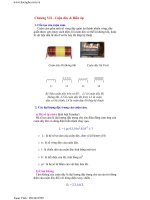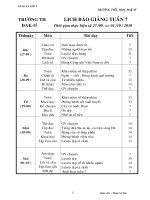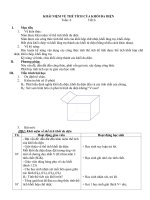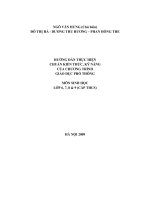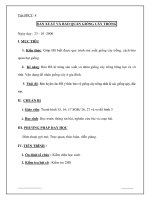SKF vibration institute brg failure presentation 7 8 2010
Bạn đang xem bản rút gọn của tài liệu. Xem và tải ngay bản đầy đủ của tài liệu tại đây (6.14 MB, 85 trang )
Vibration Institute
© SKF Group Slide 0
Vibration Institute
Piedmont Chapter
Symposium 2011
Presented by Tom McDermott
SKF Sr. Application Engineer
Friday May 13, 2011
® SKF is a registered trademark of SKF USA Inc.
© 2010 SKF USA Inc.
The contents of this publication are the copyright of the publisher and may not be reproduced (even extracts) unless prior written permission is granted. Every care has been taken to
ensure the accuracy of the information contained in this publication but no liability can be accepted for any loss or damage whether direct, indirect or consequential arising out of use
of the information contained herein.
Discussion topics
•
•
•
•
•
•
•
•
•
•
Bearing basics
Bearing life expectancy
Bearing failure statistics
Pre-operational damage
mode causes
Operational damage
mode causes
Identifying loading patterns
ISO Standard 15243
Bearing damage analysis
Securing evidence
Conducting analysis
Vibration Institute
© SKF Group Slide 2
SKF bearing basics
• Purpose and functions of a bearing
• Bearing components and materials
• Types of bearing loads
• Rolling elements – ball vs. roller
• Contact angle
• Precision class
• Radial and axial clearance
Vibration Institute
© SKF Group Slide 3
Purpose of a bearing and friction
• To provide low friction rotation of
machine parts.
• To support and locate rotating
equipment.
Resistance to motion which occurs when one
object slides or rubs against another object.
If not controlled, friction will result in:
• Heat generation
• Increased noise
Vibration Institute
© SKF Group Slide 4
• Increased wear
• Loss of power
Roles of a bearing
• Reduce friction
• Transmit loads
• Support the shaft
• Locate the shaft
Vibration Institute
© SKF Group Slide 5
Bearing components
Outer ring
Outer ring
raceway
Cage / retainer
Bore surface
Inner ring
Inner ring
raceway
Rolling elements
(balls)
Vibration Institute
© SKF Group Slide 6
OD surface
Functions of the cage
• Minimize friction and heat
generation.
• Prevent contact between adjacent
rolling elements.
• Guide the rolling elements.
• Provide a surface for the lubricant
to adhere to.
• Retain the rolling elements when
bearings of a separable design are
mounted or dismounted.
Vibration Institute
© SKF Group Slide 7
Types of bearing loads
Radial load
Axial load
Combined
load
Vibration Institute
© SKF Group Slide 8
Point and line contact
Vibration Institute
© SKF Group Slide 9
Types of rolling elements
Spherical roller
(symmetrical)
Ball
Taper roller
Cylindrical roller
Needle roller
Vibration Institute
© SKF Group Slide 10
Spherical roller
(asymmetrical)
Types of ball bearings
Deep groove
Vibration Institute
© SKF Group Slide 11
Angular contact
Self-aligning
Types of roller bearings
Cylindrical
Vibration Institute
Taper
© SKF Group Slide 12
Spherical
CARB
Load carrying capacity relative to bearing type
Load carrying capacity
is expressed as the
“basic dynamic load rating”
or “C” in catalogs
Vibration Institute
© SKF Group Slide 13
Contact angle
• The lower the contact angle, the higher the radial load capacity
• The higher the contact angle, the higher the thrust load capacity
Vibration Institute
© SKF Group Slide 14
Bearings and contact angles
As contact angle
increases, radial load
capacity decreases; and
axial load (i.e. thrust)
capacity increases.
Vibration Institute
© SKF Group Slide 15
Precision classes
Vibration Institute
© SKF Group Slide 16
Bearing internal clearances
Radial clearance
C1 < C2 < CN < C3 < C4 < C5
Note: Radial clearances are not
the same as precision classes
Vibration Institute
© SKF Group Slide 17
Axial
clearance
How does temperature affect internal clearance?
Reduced
radial
clearance
Compression
Expansion
Vibration Institute
© SKF Group Slide 18
Bearing life expectancy
Based upon five assumptions :
1. The bearing is defect free.
2. The correct bearing type and size is selected for the
application.
3. Dimensions of the bearing mating parts are correct.
4. The bearing will be mounted without damage.
5. Good lubrication in the correct quantity will always be
available to the bearing.
Vibration Institute
© SKF Group Slide 19
Circle of bearing life
Vibration Institute
© SKF Group Slide 20
Why bearings fail
Four predominant
causes of premature
bearing failure
• 90% of bearings outlive
their machinery
• 9.5% of bearings will be
removed for preventative
reasons
• 0.5% of bearings fail in
their application (and this
is generally preventable)
16% Poor Installation
36% Poor Lubrication
14% Contamination
34% Fatigue
Vibration Institute
© SKF Group Slide 21
Pre-operational damage mode causes
• Damage during transportation, handling and storage.
• Incorrect shaft and housing fits.
• Defective bearing seats on shafts and in housings.
• Faulty mounting practices.
• Static misalignment.
• Passage of electric current through the bearing.
Vibration Institute
© SKF Group Slide 22
Operational damage mode causes
• Static vibration
• Operational misalignment
• Ineffective sealing
• Ineffective or inadequate lubrication
• Passage of electric current through the bearing
• Excessive loading
Vibration Institute
© SKF Group Slide 23
Identifying loading patterns: inner ring rotation
Load
Load
Zone
Load
Zone
Vibration Institute
© SKF Group Slide 24
